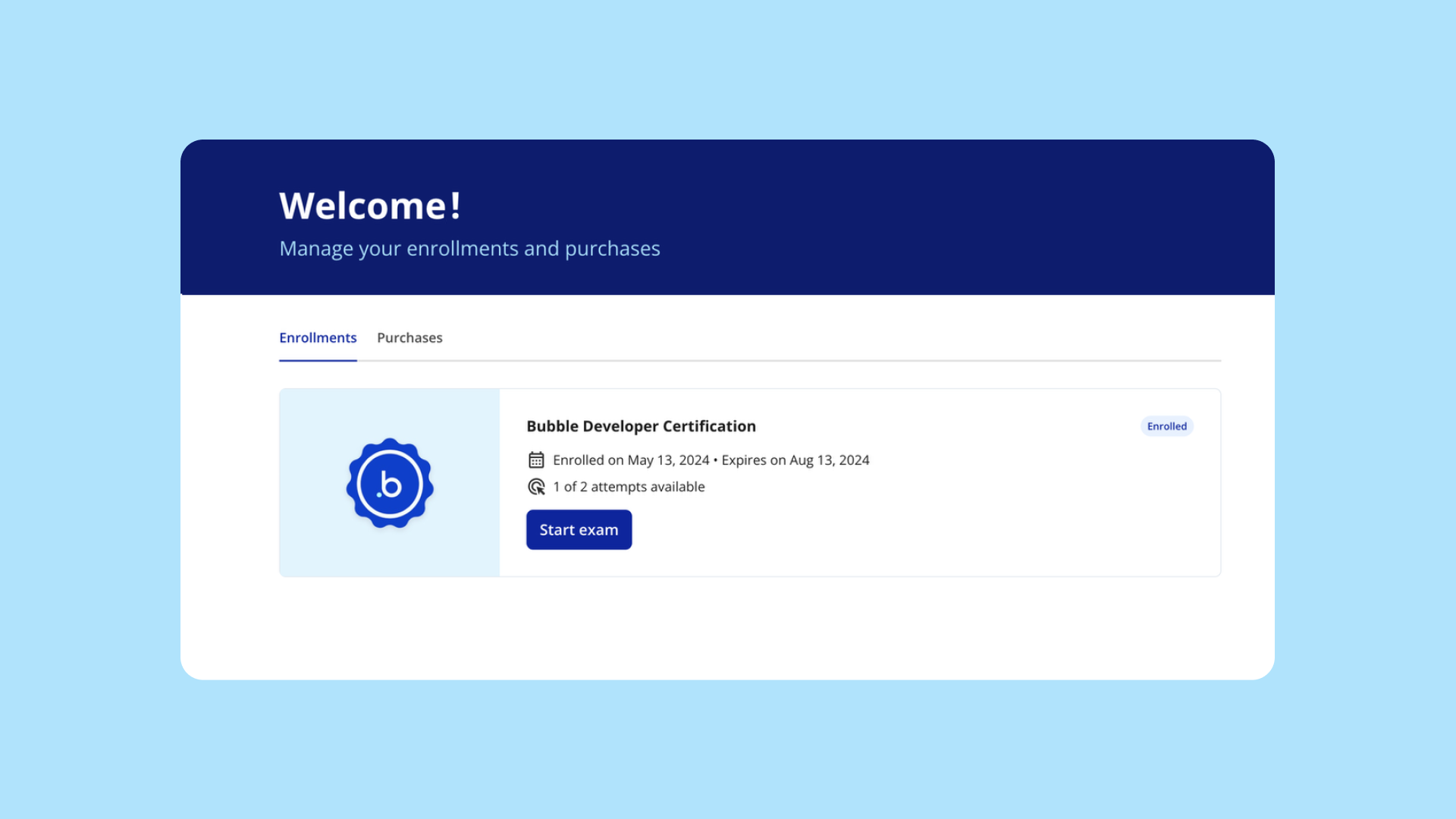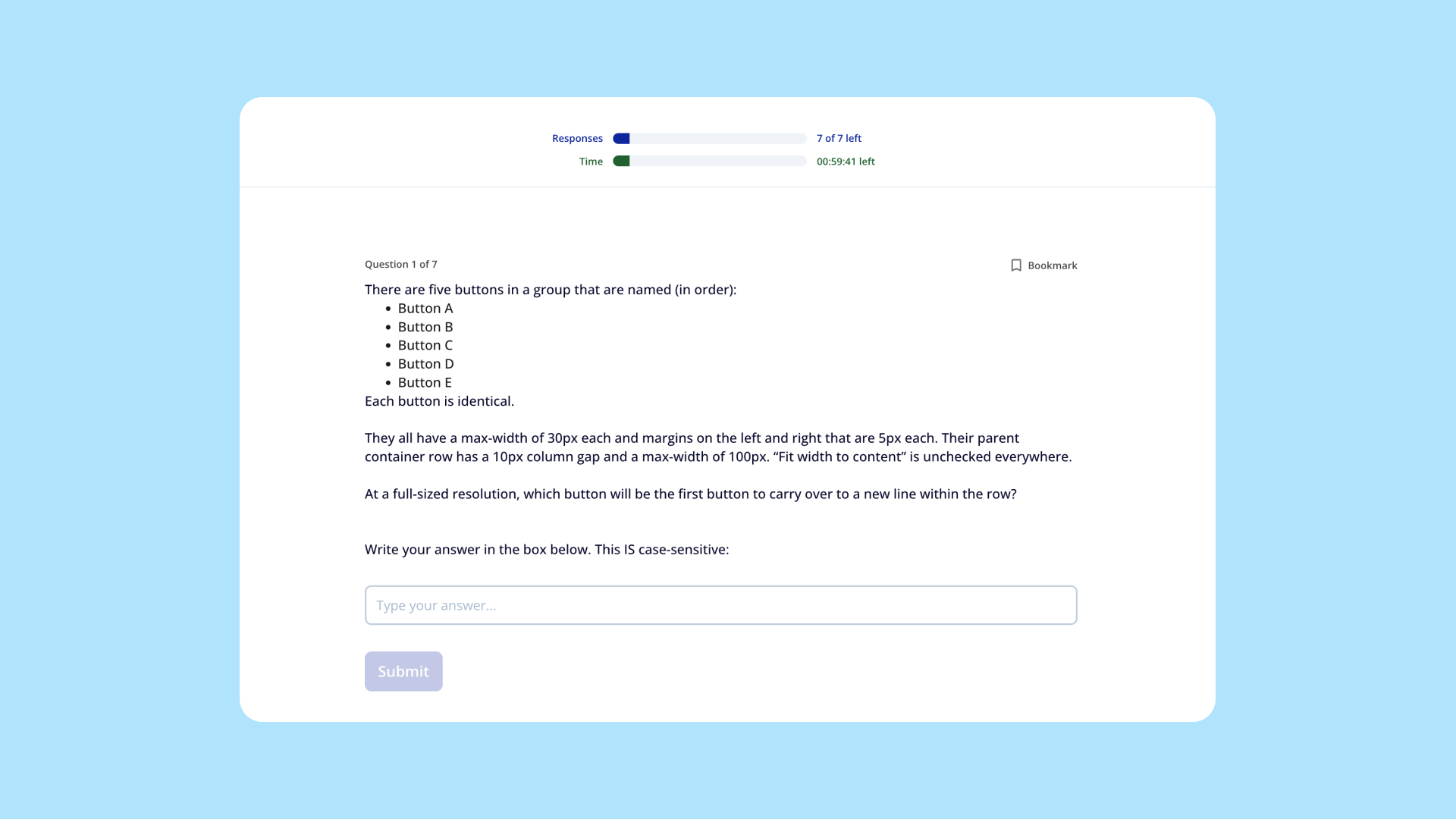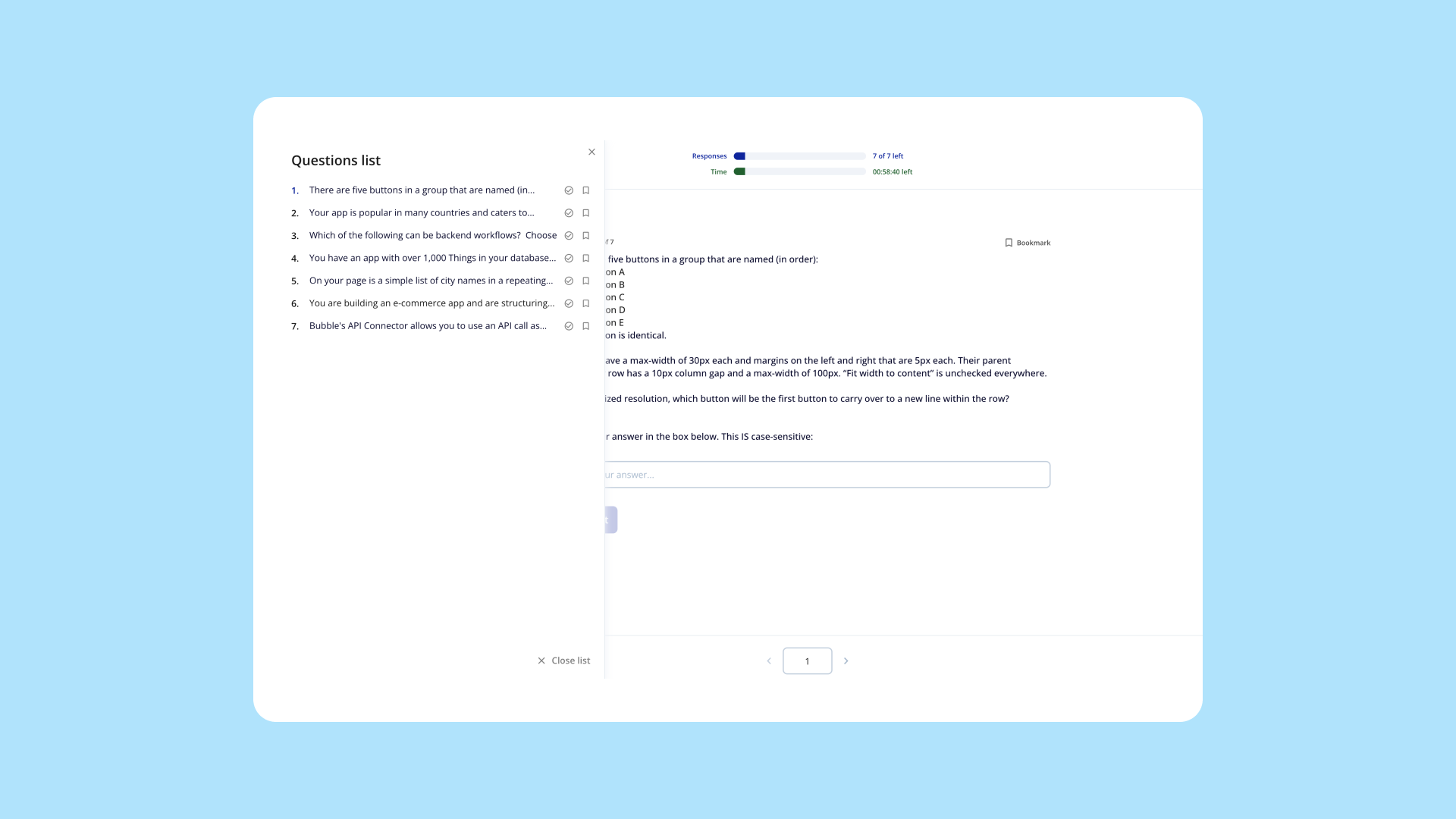Big news: Our Bubble Developer Certification is getting a major revamp — and we couldn’t be more delighted to have partnered with Airdev for the upgrade.
In October 2023, we introduced the Bubble Developer Certification to create a rigorous, universal standard for professional Bubble Developers. We launched the exam with conviction, but also with the self-awareness that it was a true V1 that would evolve with time and feedback. The response has been tremendous — today, we have 400+ Bubble-Certified Developers in our directory and have seen a 418% increase in people looking to hire Bubble Developers in the past year.
But critically, we’ve heard from the community that along with the good, there have also been serious challenges. We initially built the exam on an established third-party tool to suss out our “unknown unknowns” quickly and efficiently — and in that sense, our V1 was a success. But from UX issues and crashes during exams to administrative problems and data export frustrations, we quickly recognized that if certification was to grow into the reputable program we envisioned, it needed true investment and we needed to be able to control and customize the end-to-end experience. It needed to be built on Bubble.
Today, we’re over the moon to share that, in partnership with Airdev, we’ve done just that: We rebuilt the Bubble Developer Certification entirely on our own platform. This is the story of our rebuild journey, from why we outsourced development to how the experience may expand in the future. Settle in — it wouldn’t be any fun if we kept this story (or the results!) to ourselves.

What’s new in the Bubble Developer Certification platform
Our revamped certification platform isn’t just a tool — it’s a showcase of what’s possible on Bubble, designed to provide a best-in-class user experience.
The most immediate and obvious benefits of our new rebuild are widely focused on the exam user experience, including:
- Navigation: It’s much easier to maneuver your way through the exam — you can even bookmark questions to come back to them later.
- Reliability: We’ve reduced our exam crash rate from 5% to virtually zero.
- Proctoring: Our new proctoring service won’t cause any interruption during your exam and has 24/7 support for any unexpected issues.
- Bulk purchases: For agencies purchasing for their developers, bulk purchases are now much easier and can be done at any time — you can even track your bulk purchases and see who's used seats.
- Unified UI: The certification dashboard and exam now match the Bubble brand look and feel.


Additionally, we’ve updated the exam management experience for ease and flexibility:
- Lockout period: There’s a shorter lockout period after two failed exam attempts (three weeks instead of three months).
- Certificate transferability: If you’re a solo Bubble Developer who decides to join an agency (or vice versa), you can transfer your certification, no strings attached.
- Enrollment: Unenroll yourself and re-assign enrollments to anyone you’d like, so long as you haven’t taken one of your two attempts (especially useful for bulk purchases!).
- Name confirmation: You’ll always be prompted to confirm that your first and last names are correct before you receive your certificate.
Back to square one: Getting clear on our rebuild objectives
You might be wondering why we originally built the Bubble Developer Certification on a third-party platform. Confession: This was our first time building a certification program and we thought it best to turn to an existing platform with an established track record. We wanted to learn from those who already knew the ropes and opted for an out-of-the-box option.
Once we were live and able to understand user behavior and platform reliability, we grew more and more confident that building and scaling certification on Bubble itself would provide a smoother, more efficient, and more customized experience than our off-the-shelf tool. Designing and developing on Bubble would enable the higher-caliber experience our users deserve.
With this in mind, we named three goals for the transition from third-party tool to Bubble:
- User experience, reliability, and scale
- Integration and end-to-end consistency
- Cost-efficiency (like many of the founders we support, we’re judicious about budget, too)
We knew we wanted to move quickly on the rebuild — there was just one hiccup: Our in-house Bubble Developers were already allocated to other prioritized projects.
How we chose Airdev as our development partner
To keep our internal team on track, we assembled a Request for Proposal (RFP) to vet agency partners for our own project. There were two key things that made this process relatively quick and straightforward: We prepared a complete scope of work to share with potential dev partners in advance, and we were clear about our budget for this project.
The outlined scope of work delineated both the frontend and backend functionalities of our application. With only a few months to work with, we knew the importance of being strategic in prioritizing the crucial features for getting us to par with our third-party tool, all while still enhancing the overall experience. As we worked through our requirements, anything deemed non-essential was categorized as "nice to have" and tabled for the time being.
We received eight proposals from Gold agency partners and evaluated them one by one. We had several conversations and carefully discussed each project proposal to gauge its alignment with our requirements. We ultimately decided to work with Airdev.
Why Airdev? From the get-go, they gave us confidence in our partnership with their understanding of our scope and core needs. As the largest Gold agency, with 35 certified developers on staff, they had a vested interest in making sure the user experience was flawless.
“This project was mission-aligned because we want to prove that Bubble (the platform) can handle a critical function for Bubble (the company) – and we want to support Bubblers getting certified,” shares Andrew Haller, Airdev’s co-founder and co-CEO. We were off to the races.
Plunging head-first into the development journey
Part of what made the development journey so successful was a clear and candid outline of our three-month timeline upfront, from initial planning to launch.
Kick-off and alignment
Once our contract was signed and sealed, it was time to hit the ground running. Airdev had mockups to share just four days later. “We had ideas from the beginning of how to improve the system based on our own experiences getting certified, so we were excited to make the platform better for others,” says Andrew.
Data migration and security
Taking data out of a system is never easy — that said, Bubble’s database and ability to set up API endpoints between our main Bubble app and our new certification app was a relative breeze compared to most third-party tools.
When it came to data security and permissions, integrity was top of mind for both us and Airdev. Because they’re an agency that benefits from the exam and industry certification, we wanted to make sure Airdev wouldn’t gain an unfair advantage by having access to certification data. We could configure Bubble’s collaborator permissions so that live data and exam questions in our test environment wouldn't be shared with the agency. That meant we were able to preserve access to sensitive information and retain sole permissions of the app and its data once we were live. In the same way, Airdev also never had access to any of our users’ data.
Testing
Throughout the process, we had both internal team members and external developers from our Certification Advisory Committee (CAC) testing the experience and stability of the new app. Some of these testers weren’t yet certified, and this provided a practical way to both stress test the app and get them certified. (Many thanks and congrats to this remarkable group!)
Challenges and points of ease
We knew that the Bubble platform was more than capable of supporting this massive rebuild. But we also knew we’d need to take on the management intricacies of running the certification program itself — all the little things that needed to be accounted for. Andrew explains, “Like many quiz and form-type apps we had made in the past, there are hidden complexities — like how to handle versioning as Bubble updates questions and answers, or how purchases, enrollments, and attempts fit together.”
One of the biggest pain points pre-rebuild was accepting that we had to take down the entire certification exam to make updates — this was hardly the user experience we envisioned. With the help of Airdev, we built a full version control system that allows our internal team to edit and maintain exam questions — all while preserving historical answer accuracy — without ever needing to take the exam offline for everyone. This is a huge improvement from our old platform experience.
Building out the backend system to manage the full app went particularly smoothly. Bubble makes it incredibly easy to design the backend and create a matching frontend — everything from managing users and enrollments to viewing exam attempts was simple and even fun to build — and a massive improvement to behind-the-scenes operations.
Certification Advisory Committee
Bubble’s Certification Advisory Committee has been an integral part of the certification journey from the program’s inception. With the help of our CAC, we build direct lines of communication to what users and agencies are seeing and experiencing. They help with questions and are the first to inform us when certification helps elevate their businesses.
The Bubble Developer Certification wouldn’t be what it is without them. With their help and support testing our new platform, we’re confident that our new certification experience delivers the quality experience the Bubble community deserves.
Impact that highlights the power of no-code
At the end of the day, we’ve poured our energy into this rebuild because the Bubble Developer Certification is a long-term investment — not just for us, but for the no-code community at large:
- For individuals taking the certification exam, you can expect a reliable exam with a noticeably better user experience.
- For agencies, you’ll notice an improved bulk-purchasing experience with polished and practical user management features.
For our internal Bubble team, we now have more control over the experience and a direct line to our users — plus, building on Bubble was a no-brainer way to keep things cost-effective for our business. By leveraging our own platform, we’ve created a tight connection between the certification process and our community. Users can expect quicker updates and enhancements based on feedback, as the certification system is now coupled with our core platform.
Building for the future
Beyond the surface-level improvements, we’re excited that this rebuild enables us to scale our certification program, improve our exam, and open the door for future education opportunities. We’re already scoping new features and expansion possibilities, and are focused on making sure this platform scales with demand. This wouldn’t be possible without the robust community that has sprouted around our certification endeavor: Bubble’s agency partners have been an essential, trusted piece of the no-code ecosystem puzzle. Without Airdev in particular, it’s possible this effort would still be collecting dust in our backlog.
In the long-term, we recognize the strategic importance of having the Bubble Developer Certification system built on Bubble — it’s key for no-code ecosystem growth and developer engagement, and a responsibility we take to heart.
What did we learn through this journey? Never underestimate the power of what can be built quickly when motivated minds come together. When developers and agencies see Bubble being used for something as crucial as our own certification, it’s a testament to the strength, trust, and versatility of the platform in action. Despite all-too-common perceptions the other way around, Bubble was the best solution for the long-term, scalable product — not the MVP — and we couldn’t be more proud.
Build for as long as you want on the Free plan. Only upgrade when you're ready to launch.
Join Bubble







